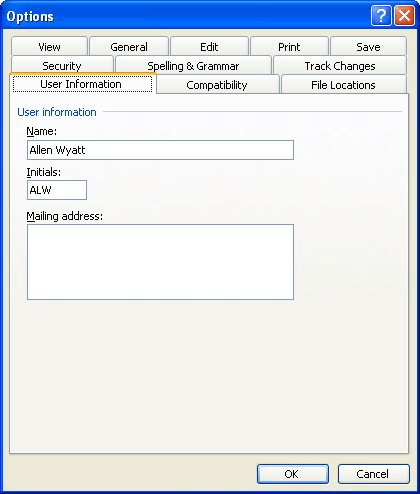Please Note: This article is written for users of the following Microsoft Word versions: 97, 2000, 2002, and 2003. If you are using a later version (Word 2007 or later), this tip may not work for you. For a version of this tip written specifically for later versions of Word, click here: Consolidating Changes under a Single User.
The Track Changes feature of Word comes in very handy when you want to track who makes what changes to a document. The feature makes it easy to see edits, along with the name of the person who made the change.
In some office situations, you may want changes to be done by multiple people, but to have those changes appear in the document as if they were done by a single person. For instance, your boss might make some changes in a document, and then hand a marked-up copy of the printed document to an assistant to enter more changes. Rather than have these other changes appear as if they were done by the assistant, you would probably want them to show as being done by the boss. (This makes sense—they were the boss' changes to begin with; someone else just entered them.)
There are a couple of ways this can be done in Word. The most obvious way would be for the assistant to do the changes using the boss' computer. This may not be practical, however, since the boss may not want his or her computer to be used by anyone else, or the boss' computer may be a portable that travels with the boss.
That leads to another approach—pretend to be the boss. When you have the Track Changes feature turned on in Word, it stores a user name with each change made in a document. This name is taken from the name and initials you have set up in Word. (You do this on the User Information tab of the Options dialog box.)
If you want to pretend you are the boss, so that your edits show up as the boss' edits, just change the name and initials to match whatever is on the boss' system. The information has to match exactly, or Word will still consider your edits to be different from the boss' original edits. A helpful way to make sure you get everything the same is to follow these steps on the boss' computer:

Figure 1. The User Information tab of the Options dialog box.
You now have a hardcopy of what the boss' user information looks like, which means you can match it exactly within your system.
One thing you should be aware of is that the information on the User Information tab is not used just for Track Changes. It is used in other places, as well. For instance, it appears in the file properties associated with a file, as well as when you insert comments. It also shows as the results for various field codes. Thus, it is a good idea to change your User Information tab only when you are going to work on the boss' document, and then change it back to your information as soon as you are done with the document. If you have to do this switch regularly, you may want to record the process into a macro that you can later replay to automatically make the change.
WordTips is your source for cost-effective Microsoft Word training. (Microsoft Word is the most popular word processing software in the world.) This tip (3800) applies to Microsoft Word 97, 2000, 2002, and 2003. You can find a version of this tip for the ribbon interface of Word (Word 2007 and later) here: Consolidating Changes under a Single User.

Learning Made Easy! Quickly teach yourself how to format, publish, and share your content using Word 2021 or Microsoft 365. With Step by Step, you set the pace, building and practicing the skills you need, just when you need them! Check out Microsoft Word Step by Step today!
If your document has a lot of markup visible in it, you may want to print a copy of the document that doesn't reflect ...
Discover MoreTrack Changes is a valuable Word tool that allows you to automatically mark changes in your document. This is a great ...
Discover MoreTrack Changes is a great tool to use so that you can, well, "track" what changes are made during the development of a ...
Discover MoreFREE SERVICE: Get tips like this every week in WordTips, a free productivity newsletter. Enter your address and click "Subscribe."
There are currently no comments for this tip. (Be the first to leave your comment—just use the simple form above!)
Got a version of Word that uses the menu interface (Word 97, Word 2000, Word 2002, or Word 2003)? This site is for you! If you use a later version of Word, visit our WordTips site focusing on the ribbon interface.
Visit the WordTips channel on YouTube
FREE SERVICE: Get tips like this every week in WordTips, a free productivity newsletter. Enter your address and click "Subscribe."
Copyright © 2026 Sharon Parq Associates, Inc.
Comments